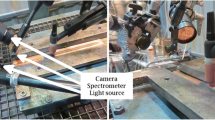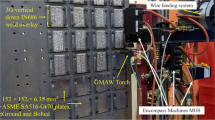Abstract
The role of minor elements in the development, intensity and composition of slag islands visible on the weld bead was investigated. Thirty-one very low sulphur heats of ferritic stainless steel EN 1.4509 (“441”, S43940) were autogenously gas tungsten arc welded using multiple welding scenarios. The welds were analysed by using conventional metallography and scanning electron microscopy. Furthermore, the level of penetration was examined as the phenomena are connected to each other. There were two types of slag: (1) slag associated with arc ignition comprising mainly Al2O3-rafts and Al2O3-rich Al2O3-CaO, which was promoted by the presence of aluminium in the steel and high arc voltage, and (2) slag spots comprising TiO2-rich TiO2-CaO-Al2O3 with less than 40 % Al2O3. The extent of slag spots increased with increasing calcium and titanium in the steel but decreased with increasing aluminium. Calcium and titanium intensified the slag island formation and severely impaired penetration. Silicon had a detrimental effect on weld penetration but had no effect on slagging. Aluminium had a decisive role in the formation of ignition slag, but had no clear effect on slag spot formation or penetration. No statistically significant effect of sulphur or oxygen on weld penetration was found for the ranges studied.









Similar content being viewed by others
References
Heiple C, Roper J, Stagner R, Aden R (1983) Surface active element effects on the shape of GTA, laser and electron beam welds. Weld J 72–77
Mills KC, Keene BJ (1990) Factors affecting variable weld penetration. Int Mater Rev 35:185–216. doi:10.1179/095066090790323966
Modenesi PJ (2015) The chemistry of TIG weld bead formation. Weld Int 1–12. doi: 10.1080/09507116.2014.932990
Mills KC, Keene BJ, Brooks RF, Shirali A (1998) Marangoni effects in welding. Philos Trans R Soc A Math Phys Eng Sci 356:911–925. doi:10.1098/rsta.1998.0196
Pollard B (1988) The effects of minor elements on the welding characteristics of stainless steel. Weld J 202–213
Harvey MDF, Rodwell MH (1988) The influence of TIG welding procedure on slag island formation on a type 316 stainless steel—a case study. TWI Industrial Member Report Summary 358/1988
Matsuhashi T, Nakata M (2013) Patent US20130129560A1
Collins S (1997) Stainless steel for semiconductor applications. Mech Work steel Process Conf … 607–619
Rau J (2003) The effect of trace elements on the formation of slag spots during gas tungsten arc welding of 316 L stainless steel tube systems. csidesigns.com 1–7
Mills KC, Brooks RF, Shirali A (1992) The effect of low levels of calcium on weld penetration. Comm Eur Communities 70
Leinonen JI, Järvenpää SA, Karjalainen LP (1992) Harmful effect of calcium on weld penetration characteristics. Intl Conf Trends Weld Res 712–717
Burgardt P, Campbell RD (1992) Chemistry effects on stainless steel weld penetration. Key Eng Mater 69–70:379. doi:10.4028/www.scientific.net/KEM.69-70.379
Burgardt P, Heiple C (1986) Interaction between impurities and welding variables in determining GTA weld shape. Weld J 150–155
Lambert J (1989) Welding procedure selection to minimise cast-to-cast variability in thin section TIG (tungsten inert gas) butt welds. CEGB Report RD/M/1784/RR89
Metcalfe JC, Quigley MBC (1977) Arc and pool instability in GTA welding. Weld J 133–139
Acknowledgments
This research work was carried out as part of the Finnish Metals and Engineering Competence Cluster (FIMECC)’s Breakthrough Steels and Applications (BSA) program. The authors are grateful to the Finnish Funding Agency for Technology and Innovation (Tekes) and Outokumpu Oyj for financial support. S.A. is also grateful to the Technology Industries of Finland Centennial Foundation Fund for the Association of Finnish Steel and Metal Producers and for the support from Outokumpu Stainless Oy, Tornio Research Centre.
Author information
Authors and Affiliations
Corresponding author
Additional information
Recommended for publication by Commission IX - Behaviour of Metals Subjected to Welding
Rights and permissions
About this article
Cite this article
Anttila, S., Lauhikari, V., Heikkinen, HP. et al. Slag island characteristics and weld penetration in very low sulphur 18 % Cr stabilized ferritic stainless steel. Weld World 60, 485–496 (2016). https://doi.org/10.1007/s40194-016-0311-2
Received:
Accepted:
Published:
Issue Date:
DOI: https://doi.org/10.1007/s40194-016-0311-2




